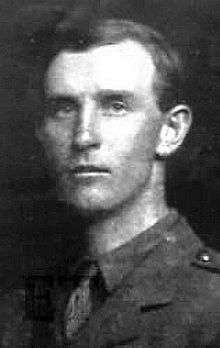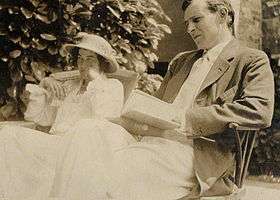Raymond Asquith
| Raymond Asquith | |
|---|---|
 | |
| Born | 6 November 1878 |
| Died |
15 September 1916 (aged 37) Near Ginchy, France |
| Resting place | CWGC Guillemont Road Cemetery |
| Nationality | British |
| Education | Winchester College, Balliol College, Oxford |
| Occupation | Lawyer |
| Spouse(s) | Katharine Frances Horner |
| Children |
|
| Parent(s) |
|
Raymond Herbert Asquith (6 November 1878 – 15 September 1916) was an English barrister and son of British Prime Minister H. H. Asquith. A distinguished Oxford scholar, he was a member of the fashionable group of intellectuals known as The Coterie, notable for their unconventional lifestyles and lavish hospitality. Like several of them, Asquith was killed in action in the First World War.
Career and honours
Asquith was the eldest son and heir of British Prime Minister H. H. Asquith. by his first wife Helen Kelsall Melland (died 1891).
He was educated at Winchester, from where he won a scholarship to Balliol in 1896, taking with him a reputation for brilliance. He won the Ireland, Derby, and Craven scholarships, and graduated with first-class honours. Elected a fellow of All Souls in 1902, he was called to the bar in 1904.[1] The tall, handsome Asquith was a member of "the Coterie," a group of Edwardian socialites and intellectuals.
Asquith was junior counsel in the North Atlantic Fisheries Arbitration and the British Wreck Commissioner's inquiry into the sinking of the RMS Titanic, and was considered a putative Liberal candidate for Derby. However, his rise was interrupted by the outbreak of the First World War. He was initially commissioned, on 17 December 1914, as a second lieutenant into the 16th (County of London) Battalion, London Regiment.[2] He was transferred to the 3rd Battalion, Grenadier Guards, on 14 August 1915[3] and assigned as a staff officer, but he requested to be returned to active duty with his battalion, a request granted before the Battle of the Somme.
While leading the first half of 4 Company in an attack near Ginchy on 15 September 1916, at the Battle of Flers-Courcelette, he was shot in the chest but famously lit a cigarette to hide the seriousness of his injuries so that his men would continue the attack.[4] As a result, he died while being carried back to British lines. He was buried at Guillemont in the CWGC Guillemont Road Cemetery, [Plot I. Row B. Grave 3.] where his headstone is inscribed 'Small time but in that small most greatly lived this star of England',[5] a concluding line from Shakespeare's Henry V, about a warrior king who died in his thirties after campaigns in France.
The writer John Buchan devoted several pages of his autobiography Memory Hold-the-Door to his memories of Raymond Asquith and their friendship.
.jpg)
_(cropped).jpg)
Memorials
A memorial tablet to Asquith was erected in Amiens Cathedral. The inscription, in French and Latin, states:
Priez pour l'âme de RAYMOND ASQUITH Lieutenant aux Grenadiers de la Garde Royale. Fils ainé de Herbert Henry Asquith premier ministre du Royaume Uni. Né le 6 Nov. 1878. Tombé au champ d'honneur près de Guinchy le 15 Sept. 1916.
O ORIENS SPLENDOR LUCIS AETERNAE VENI ET ILLUMINA SEDENTES IN TENEBRIS ET UMBRA MORTIS. Gloriae memor posuit conjux.
He is also the subject of a memorial in St Andrew's Church near the family home in Mells in Somerset, and is listed on Mells War Memorial; both memorials were designed by Sir Edwin Lutyens, a friend of the Asquith family.[6] The St Andrew's Church memorial wording is:
In piam memoriam Raymondi Asquith Coll. Wintoniensis et Balliolensis scholaris Coll. Omnium Animarum socii qui in foro et republica ad omnia ingenii virtutisque praemia spe et votis aequalium destinatus medio in flore aetatis armis pro patria sumptis fortiter pugnans occidit defunctum terra tenet longinqua et amica desiderio inexpleto prosequuntur sui
N. VI NOV. MDCCCLXXVIII OB. XV SEPT. MCMXVI[7]
This translates as:
In loving memory of Raymond Asquith Scholar of Winchester College and Balliol College Fellow of All Souls College Who was destined by the hopes and desires of his contemporaries To win all the rewards of intellectual talent and virtue. In the middle of the flower of his life He took up arms for his native-land and died fighting bravely. A distant and friendly land holds him now he is dead. His family and friends mourn him with unrequited longing. Born on the 6th of November 1878, died on the 15th September 1916.[8]
Family

Raymond Asquith was married on 25 July 1907 to Katharine Frances Horner (1885–1976),[9][10] younger daughter[11] of Sir John Francis Fortescue Horner, of Mells, Somerset, descended from 'Little Jack Horner' of nursery song fame.[12] Her mother, Lady Horner (d. 1940), was Frances Jane Graham, elder daughter of William Graham, a rich merchant, passionate art collector, and Liberal member of parliament for Glasgow.[13] Lady Horner was a notable hostess and patron of the arts, especially the Pre-Raphaelites and John Singer Sargent. The Horners had four children – Cicely (born 1883), Katharine (1885), Mark (who died in his teens), and Edward (1888).
Asquith and his wife had three children:
- Lady Helen Frances Asquith (1908–2000), who died unmarried
- Lady Perdita Rose Mary Asquith (1910–1996) who married the 4th Baron Hylton (d 1967)
- Julian Edward George Asquith, 2nd Earl of Oxford and Asquith (1916–2011), nicknamed Trim,[14] who was born a few months before his father's death on active service. The new baby was reputedly named "Trim" in honour of the Roman gourmand Trimalchio, after his father saw his newborn son for the first time while on leave from the war.[15]
Asquith died nearly ten years before his father was raised to the House of Lords in 1925 as Earl of Oxford and Asquith. Katharine eventually inherited Mells Manor because her younger and only surviving brother, Edward Horner (1888–1917), was also killed in the war.[16] He was buried in France, but his memorial in St Andrew's Church, Mells was designed by his mother's friend Edwin Lutyens, who was a patron of Monsignor Ronald Knox. Katharine converted to Roman Catholicism after being widowed and became a friend of Siegfried Sassoon, who also converted, following her example.[17] She also remained in touch with Evelyn Waugh, another convert.[18] All three of her children were brought up as Roman Catholics.
References
- ↑ Asquith and the Conspiracy to Sink Titanic: ET Research (2004) by Senan Molony – 9 July 2004. Encyclopedia-titanica.org. Retrieved on 2012-06-24.
- ↑ "No. 29027". The London Gazette. 1 January 1915. p. 132.
- ↑ "No. 29262". The London Gazette. 13 August 1915. p. 8024.
- ↑ Farrah-Hockley, Anthony (1966). The Somme. p. 238.
- ↑ CWGC. CWGC (1916-09-15). Retrieved on 2012-06-24.
- ↑ Historic England. "Mells War Memorial (1058315)". National Heritage List for England. Retrieved 7 February 2016.
- ↑ Pym, Dora; Silver, Nancy, eds. (1952). "Raymond Asquith's Epitaph". Alive on men's lips: an anthology of Rome and the Latin language in the life of twenty centuries. p. 142.
- ↑ Inglis, Susan (18 September 2008). "A Visit to… Mells". Retrieved 18 January 2018.
- ↑ Lundy, Darryl. "Katharine Frances Horner". The Peerage. Retrieved 29 January 2018.
- ↑ The Papers of Alfred Duff Cooper (1st Viscount Norwich). janus.lib.cam.ac.uk
- ↑ See Oxford DNB: Frances Horner and Encyclopedia Titanica. Her elder sister Cicely Horner (1883–1972), wife since 1908 of the Hon. George Lambton (1860–1945), fifth son of the 2nd Earl of Durham was painted by John Singer Sargent.
- ↑ "A Journey to Mells". Archived from the original on 5 December 2008. Retrieved 24 June 2012. . andrewcusack.com (2006-02-14).
- ↑ theglasgowstory.com
- ↑ Lundy, Darryl. "Edward Julian George Asquith, 2nd Earl of Oxford and Asquith". The Peerage. ,
- ↑ Clarissa Eden (2007) A Memoir: From Churchill to Eden
- ↑ "Apollo Magazine, 7 August 2007,". Retrieved 5 February 2008.
- ↑ "Mells Report" Archived 28 July 2011 at the Wayback Machine.. Warpoets.org. Retrieved on 2012-06-24.
- ↑ "Without Waugh, there would be no adventure – Telegraph". Telegraph.co.uk (2003-05-27). Retrieved on 2012-06-24.
Sources
- Oxford Dictionary of National Biography. K. D. Reynolds, ‘Horner , Frances Jane, Lady Horner (1854/5–1940)’, first published September 2004, 580 words, with portrait illustration. Oxford DNB: Frances Horner (citation only), full article available via subscription only.
External links
- Photographs of Raymond Asquith and his wife at the NPG taken by Lady Ottoline Morrell.
- A fuller profile of Raymond Asquith including the text of his Times obituary.
- Mells, Somerset